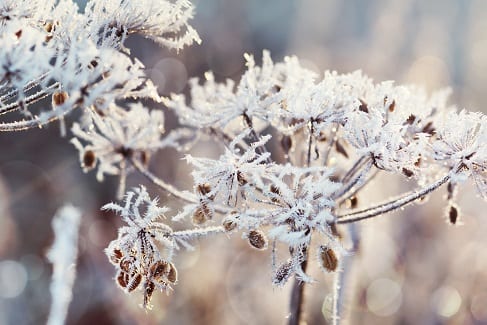Frost can be both a blessing and a curse for gardeners. For example, Brussels sprouts taste much sweeter after being frosted, whereas tree blossom can be totally wiped out by an early or late frost. Here are some of the top plants for frost pockets.
Frost pockets are usually found where there are dips in the garden, so called because they allow cold air to collect at the bottom. It can affect all parts of the garden, but some parts more drastically than others. A pool of ground level morning mist, when other areas have cleared, is usually a sign of one.
Nearby hills can also cause problems on frosty nights as cold air collects on trees, sinks to the ground, then flows down the hill. It then collects in the low points of yours and your neighbours’ gardens.
Lessen the impact

Fences, walls, and solid hedges near or around those dips can cause more extreme frost pockets.
Making a few gaps at the lowest point of those barriers should allow the cold air to drain away and hopefully either completely remove the frost pocket issue or at least lessen its impact.
Another way of helping plants survive in frost pockets is to plant close together. Also, improving drainage and applying a deep mulch of well-rotted organic matter in spring which will act as a protective barrier.
You can also cover plants or pots with cardboard or tarpaulin overnight to help protect the plants from the worst of the season’s frosts.
Most early flowering plants, especially fruit trees, are really difficult to grow in frost pockets, so choose later flowering varieties wherever possible.
Don’t despair though, there are plants adapted to our climate which can survive growing in these conditions.
Cirsium rivulare (plume thistle) ‘Atropurpureum’
This handsome ornamental perennial loves nothing more than to be grown in damp soil and will tolerate the damp air caused by frost pockets.
Producing deep purple-red thistle flowers on long stems during summer, they soon clump up, helping to minimise the effect of the frost pocket on other plants growing in that area. Leaving the seed heads on will provide food for birds during the autumn months. Alternatively, cut the stems back after the first flush to obtain a late season second flower flush.
- Flowers in summer
- Fully hardy
- Grows up to 1.5m tall
- Moist but well-drained soil
- Full sun
- Exposed or sheltered

Magnolia (magnolia) ‘Sunsation’
Rather than choosing early flowering magnolia varieties such as M. stellata, choose late flowering ones such as ‘Sensation’. This is an upright, medium-size tree with unusual large yellow and pink colour flowers. The flowers appear in late spring and early summer, therefore they’re at less risk of late frost damaging the flower buds
- Flowers spring to summer
- Hardy
- Grows to 4m tall
- Moist but well-drained soil
- Full sun or partial shade
- Sheltered

Hakonechloa macra (Japanese forest grass)
These small Japanese grasses also thrive in moist soil as long as it’s well drained. They form elegant clumps of slightly arching foliage which turns a lovely shade of bronze over winter, making them great for path edging.
For best results, cut overwintered foliage close to the ground before new growth starts to appear during the spring months. Help the plants cope with being in frost pockets by adding a layer of compost of well-rotted manure as mulch.
- Flowers in summer with interesting foliage year-round
- Fully hardy
- Grows to 40cm tall
- Moist but well-drained soil
- Full shade, full sun, or partial shade
- Sheltered or exposed

Verbascum nigrum (dark mullein)
These long-flowering biennial plants produce leaves in their first year of growth. The next year, the statuesque 1-metre-high stems of bright yellow flowers bloom.
They are very easy to grow from seed which means you can plant several plants to help quickly fill and cover the frost pocket area. Once established they should regenerate by self-seeding.
- Flowers in summer and autumn
- Fully hardy
- Grows up to 1m tall
- Well-drained soil
- Full sun
- Exposed or sheltered

Lythrum salicaria (purple loosestrife) ‘Robin’
Next is another tall wildflower that can often be seen growing close to ponds and alongside streams. This long flowering variety has upright stems, full of magenta pink flowers from mid-summer and prefers to grow in moist soil.
- Flowers in summer and autumn
- Hardy
- Grows up to 1.2m tall
- Poorly drained soil
- Full sun
- Exposed or sheltered


Leave A Comment